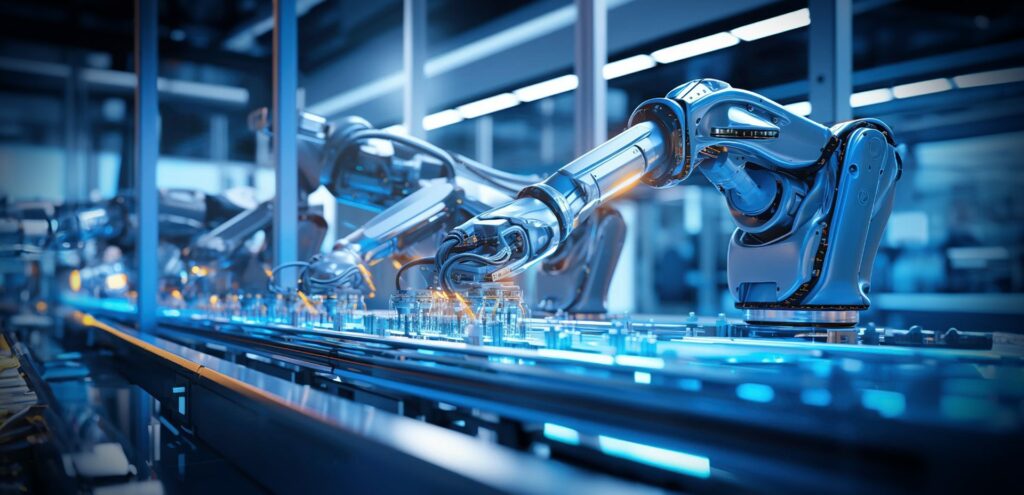In recent years, industrial automation has seen significant change, largely fueled by the adoption of collaborative robots, or cobots, within production workflows. Unlike traditional industrial robots that are typically isolated from human workers due to safety concerns and complexity, cobots are designed to work alongside humans, offering a flexible, safe, and efficient alternative.
Understanding Cobot Arms
Cobot arms, or collaborative robots, represent a significant shift in how automation is approached. These robots are built with a focus on collaboration with human workers. Unlike their traditional counterparts, cobots are designed to be easily programmed and reconfigured, making them highly adaptable to various tasks.
There are several types of cobots, each designed to fulfill specific roles within a production environment. For example:
- Articulated Cobots: Mimic the range of motion of a human arm, making them ideal for tasks requiring dexterity and precision.
- SCARA Cobots:Provide a fixed range of motion suitable for high-speed assembly and pick-and-place tasks.
- Delta Cobots: Designed for high-speed, lightweight operations, often used in packaging and sorting.
Each type has unique advantages depending on the application’s specific needs, such as payload capacity, reach, and speed.
Benefits of Integrating Cobot Arms
One of the primary advantages of integrating cobots into production workflows is the boost in efficiency and productivity. Cobots can operate around the clock, performing repetitive tasks with consistent precision and speed. This continuous operation minimizes downtime and helps increase throughput, which is crucial for meeting production targets and improving overall operational efficiency.
Flexibility and Adaptability
Cobots offer remarkable flexibility compared to traditional automation solutions. They can be easily reconfigured to perform different tasks or adapt to new product lines. This adaptability is particularly beneficial in industries where production requirements frequently change, allowing for swift adjustments without extensive downtime or retooling.
Cost-Effectiveness
Incorporating cobots can lead to significant cost savings. While the initial investment might be higher than manual labor, the long-term benefits often outweigh the costs. Cobots reduce the need for extensive safety measures, lower labor costs, and diminish the costs associated with human error and production delays. The return on investment (ROI) can be substantial, especially in high-volume production environments.
Improved Worker Safety and Ergonomics
Safety is a critical concern in manufacturing, and cobots address this by reducing the physical strain on human workers. Cobots are designed to take over dangerous or ergonomically challenging tasks, thus minimizing the risk of workplace injuries. The collaborative nature of cobots also allows for safer interactions between humans and machines, with built-in safety features that prevent accidents.
Key Considerations for Integration
Before integrating cobots, it’s essential to assess the current production workflow and identify areas where cobots can provide the most benefit. This involves evaluating the existing machinery and determining how cobots can be seamlessly incorporated. Compatibility with current systems and processes is crucial to ensure a smooth integration and minimize disruptions.
Technical and Operational Requirements
Understanding the technical specifications of cobots is vital for successful integration. Key factors include payload capacity, reach, precision, and operational speed. Additionally, operational requirements such as the need for specialized grippers or tools should be considered. Properly matching the cobot’s capabilities with production needs ensures optimal performance and efficiency.
Training and Skill Development
Integrating cobots into a production environment requires proper training for the staff who will operate and maintain the robots. Investing in training programs helps ensure that employees are comfortable and proficient with the new technology. Developing a strategy for upskilling workers and transitioning them into roles that complement the new automation can enhance overall productivity.
Steps for Successful Integration
Successful integration begins with meticulous planning and design. Conduct a feasibility study to determine how cobots can be incorporated into the existing workflow. Develop a comprehensive project plan that includes selecting the appropriate cobot models, designing the integration layout, and addressing any potential challenges.
Implementation
The implementation phase involves installing the cobots and setting them up for operation. This includes integrating the cobots with existing production systems and ensuring that all connections and configurations are properly established. Careful attention to detail during installation helps avoid issues and ensures that the cobots operate as intended.
Testing and Optimization
Once installed, cobots should undergo rigorous testing to identify and resolve any issues. Conduct trial runs to ensure that the cobots perform their tasks accurately and efficiently. Optimization involves fine-tuning the system to improve performance and address any operational challenges that arise during testing.
Monitoring and Maintenance
Ongoing monitoring and maintenance are essential to keep cobots functioning at peak performance. Implement monitoring systems to track performance metrics and schedule regular maintenance to prevent downtime. Proactive maintenance helps extend the lifespan of the cobots and ensures continuous operation.
Conclusion
Integrating cobot arms into production workflows represents a significant opportunity for enhancing efficiency, flexibility, and safety in manufacturing environments. By understanding the benefits, key considerations, and steps involved, companies can successfully adopt cobots and achieve seamless workflow automation. As technology continues to advance, cobots will play an increasingly important role in shaping the future of production.
For those considering the integration of cobots into their production processes, further exploration and consultation with experts can provide valuable insights and guidance. To stay informed about the latest developments and innovations in cobot technology, check out Universal Robotics for the most up-to-date information and industry news.
